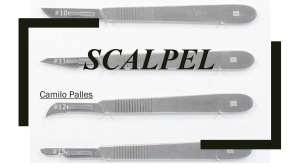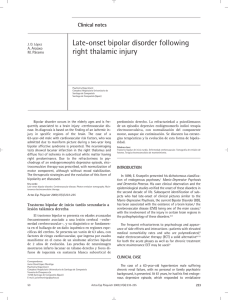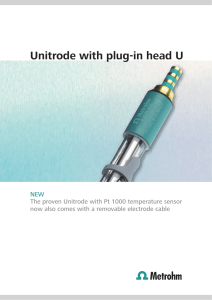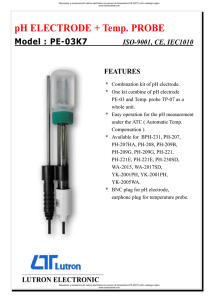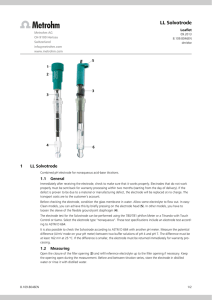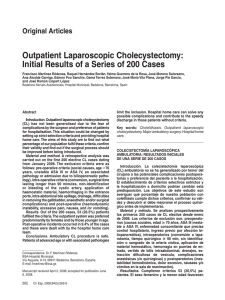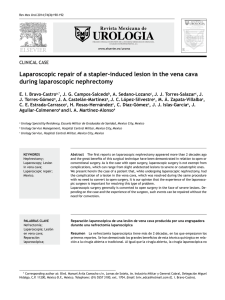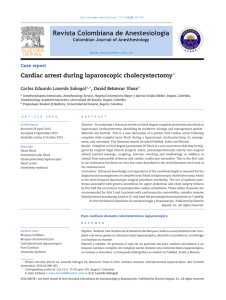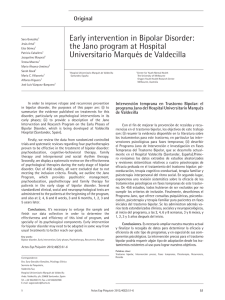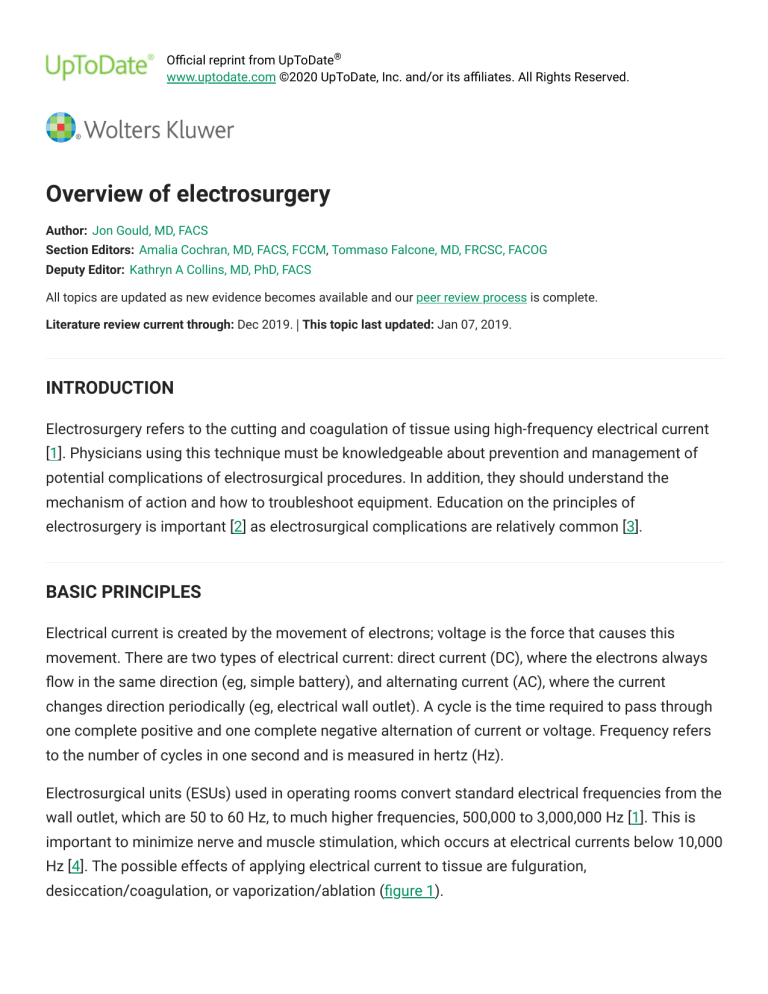
Official reprint from UpToDate® www.uptodate.com ©2020 UpToDate, Inc. and/or its affiliates. All Rights Reserved. Overview of electrosurgery Author: Jon Gould, MD, FACS Section Editors: Amalia Cochran, MD, FACS, FCCM, Tommaso Falcone, MD, FRCSC, FACOG Deputy Editor: Kathryn A Collins, MD, PhD, FACS All topics are updated as new evidence becomes available and our peer review process is complete. Literature review current through: Dec 2019. | This topic last updated: Jan 07, 2019. INTRODUCTION Electrosurgery refers to the cutting and coagulation of tissue using high-frequency electrical current [1]. Physicians using this technique must be knowledgeable about prevention and management of potential complications of electrosurgical procedures. In addition, they should understand the mechanism of action and how to troubleshoot equipment. Education on the principles of electrosurgery is important [2] as electrosurgical complications are relatively common [3]. BASIC PRINCIPLES Electrical current is created by the movement of electrons; voltage is the force that causes this movement. There are two types of electrical current: direct current (DC), where the electrons always flow in the same direction (eg, simple battery), and alternating current (AC), where the current changes direction periodically (eg, electrical wall outlet). A cycle is the time required to pass through one complete positive and one complete negative alternation of current or voltage. Frequency refers to the number of cycles in one second and is measured in hertz (Hz). Electrosurgical units (ESUs) used in operating rooms convert standard electrical frequencies from the wall outlet, which are 50 to 60 Hz, to much higher frequencies, 500,000 to 3,000,000 Hz [1]. This is important to minimize nerve and muscle stimulation, which occurs at electrical currents below 10,000 Hz [4]. The possible effects of applying electrical current to tissue are fulguration, desiccation/coagulation, or vaporization/ablation (figure 1). When comparing the creation of a surgical incision in the skin using a scalpel versus electrosurgery, no significant differences have been identified regarding infection rates or scar appearance; however, postoperative wound pain is less with electrosurgery [5]. In a randomized trial, pain scores on day 1 were lower for the diathermy group, but were no different on days 2 through 5 [6]. Monopolar versus bipolar — Electrosurgery can be performed using either a monopolar or a bipolar instrument. The main difference between these modalities is the pathway of the current. In monopolar surgery, electrical current created in the ESU passes through a single electrode to the tissue, causing the desired tissue effect (eg, fulguration, desiccation, or vaporization). The tissue effect occurs almost exclusively near the electrode, since the density of electrons diminishes rapidly as the distance from the electrode increases. To complete the cycle, however, the current needs to exit the patient, and will invariably choose the path of least resistance to return to an electron reservoir, such as the ground. In bipolar surgery, the electrical current created in the ESU is confined to the tissue between the two electrodes of the surgical instrument. The electrodes may be tines of forceps, blades of scissors, or graspers. A separate return electrode (ie, dispersion pad) to return current is not needed. Cutting and coagulation currents — The surgeon chooses the output setting for the ESU (figure 2). The main settings are "cutting" and "coagulation": ● Cutting mode – In the cutting mode, the ESU generates a continuous (or unmodulated), lowvoltage current, concentrating the energy at a small area (high current density). The cutting mode results in more rapid tissue heating than the coagulation mode. If tissue is heated rapidly, the oscillation of the alternating current causes intense vibration and heat within the cells, which causes them to explode and form smoke (plume). This is called vaporization and is the mechanism whereby tissue is cut [7]. To cut tissue, the tip of the electrode should be held very near the tissue to concentrate current at the tip, and not in direct contact with the tissue. ● Coagulation mode – In the coagulation mode, the ESU generates an interrupted (or modulated), high-voltage current, dispersed over a large surface area (low current density). As an example, the current may flow approximately 6 percent of the time and be off 94 percent of the time; these proportions can be adjusted. The modulated current allows the tissue to cool slightly, so tissue heating is slower compared with cutting mode. This results in coagulation, which is a dehydration effect (loss of cellular fluid and protein denaturation), rather than vaporization. Dehydration is not as effective as vaporization for cutting tissue but is ideal for sealing blood vessels. The modulated current requires a high power setting (higher voltage) to achieve dehydration, which causes more tissue damage and more thermal spread, increasing the risk of potential complications. For this reason, many recommend the use of the cutting mode most of the time, reserving coagulation for selected circumstances, such as in highly vascular tissue, and when dealing with tissue with poor conductivity like fatty or dry tissue [7]. In these situations, the higher voltage on the coagulation setting provides better tissue penetration. Several "blend" options are also available, combining various proportions of the two main modalities. These blends enhance the ability of cutting currents to coagulate small bleeders during dissection and coagulation currents to dissect tissue during hemostasis. Desiccation, vaporization, and fulguration — As electrical current comes in contact with tissue, heat is created because of the inherent resistance of tissue. Heat causes desiccation, vaporization, or fulguration, depending upon the ESU setting and the amount of contact between the tissue and surgical instrument. Desiccation can be produced using either the cutting or coagulation mode. It is produced by direct contact of the instrument and the tissue. Slow, superficial tissue heating results in protein denaturation, which causes the tissue to appear white. At higher temperatures, both dehydration and protein denaturation occur, resulting in desiccation. Tissue that is completely desiccated has very high resistance and does not conduct electrical current. Thus, loss of conductivity on the ESU's flow meter is an indication of complete desiccation, which is useful information during tubal sterilization or ablation of endometriosis implants. Continued application of heat with no or minimal tissue penetration results in superficial carbonization (char). Vaporization and fulguration are noncontact methods of electrosurgery. To cut tissue, the tip of the electrode should be held at the tissue surface; the high heat generated by the current vaporizes tissue immediately adjacent to the tip of the electrode without the need to press the electrode against the tissue. Since the cells "explode," no char is produced. The electrode is held a bit further away when fulgurating tissue; in this situation, electrical current (sparks) jumps or arcs between the electrode tip and the nearby tissue, which causes it to char. Fulguration is used to control bleeding over a wide area. Fulguration is a particularly useful technique to control diffuse bleeding from raw surfaces of solid vascular organs, such as the liver bed, following cholecystectomy. Time, power, tissue, and electrode — The shape and size of electrode, the time it is in contact with tissue (dwell time), the type of tissue, and the power setting of the ESU are other variables that impact electrosurgical results. The power output of the ESU is usually displayed in Watts (Watt = voltage times current). Generally, a surgeon should use the lowest possible power setting to effectively complete a procedure. A common initial setting for cutting and coagulation is 40 Watts, although there is wide individual surgeon preference and some surgeons have reported excellent results using a much higher initial setting for cutting (70 to 90 Watts) [8]. Thermal spread — Application of electrosurgery using different electrosurgical devices results in varying degrees of thermal spread. Thermal spread can cause tissue necrosis at the site of application, which may result in delayed healing and postoperative recovery [9]. Thermal spread can also cause injury to adjacent organs (eg, ureter, bladder, or bowel). Thus, it is important for surgeons to understand the potential thermal spread from specific electrosurgical devices. One comparative study used monopolar and bipolar electrocautery, the Harmonic Scalpel, and LigaSure on porcine muscle [10]. The degree of lateral thermal spread varied with instrument type, power setting, and application time. Monopolar diathermy resulted in the highest temperatures and the greatest degree of thermal spread in tissues. The expected thermal spread from several devices that are commonly used in surgery are: ● Traditional bipolar device – 2 to 22 mm [11-13]. ● Ultrasonic cutting and coagulation device – 0 to 3 mm with the Harmonic Scalpel [11,12,14,15], but is dependent upon application time and setting. A thermal spread of up to 25 mm has been reported in an animal model (with continuous ultrasonic dissection for 10 to 15 seconds at the highest level) [16]. ● Vessel sealing devices: • 1.1 mm for the EnSeal Tissue Sealing and Hemostasis System [17]. • 1.8 mm with the 10 mm LigaSure device, 4.4 mm with the 5 mm LigaSure device [18]. • 6.3 mm with the Gyrus Plasma Trissector. One comparative study found less thermal spread with the EnSeal Tissue Sealing and Hemostasis System compared with the Gyrus Plasma Trissector, LigaSure, and SonoSurg [17]. However, another study found that the Harmonic Scalpel was associated with less thermal spread than EnSeal Tissue Sealing and Hemostasis System, LigaSure, or Gyrus Plasma Trissector [19]. High-quality comparative studies are needed to evaluate the relative thermal damage caused by each device. Smoke plume — The smoke plume generated by electrosurgical destruction of tissue contains potentially toxic substances. In high concentrations, these substances can irritate the eyes and respiratory tract of individuals in the operating room and can even transmit viruses. For this reason, smoke should be captured and evacuated using suction and smoke evacuation devices. CLINICAL USE Monopolar electrosurgery — Either the cutting (low voltage) or coagulation (high voltage) mode may be used to achieve the desired tissue effect. The cutting mode is preferred when thermal spread is undesirable, such as in close proximity to the ureter, bowel, or other vital structures. It may also be prudent to use the cutting mode during desiccation of deep lesions (eg, endometriosis) since the electrical current penetrates deeper into the tissue during the cut mode. Due to higher voltage, the coagulation mode achieves better penetration through high-resistance areas, such as fatty tissue or scar tissue, and is also more applicable when fulgurating a large surface area with superficial bleeders, such as might be encountered following ovarian cystectomy or laparoscopic cholecystectomy. To minimize unwanted effects, we suggest the following [1,2]: ● Use lowest possible power setting ● Use a low voltage waveform (cut) ● Use brief, intermittent activation ● Do not activate in open circuit ● Do not activate in close proximity or direct contact with another instrument ● Use bipolar electrosurgery where appropriate ● Use an all-metal or all-plastic cannula system (not metal-plastic hybrids) ● Use a return electrode monitoring system ● Use active electrode monitoring to eliminate concerns regarding insulation failure and capacitive coupling during hysteroscopic and laparoscopic electrosurgical procedures If the desired tissue effect is not achieved at usual power settings, the surgeon should check all of the equipment, including removing excessive char on the electrode, before increasing the power setting to high levels. Bipolar electrosurgery — Bipolar electrosurgery is generally performed at low voltage (cutting mode) since tissue impedance is relatively low due to the proximity of the two electrodes. For this reason, these instruments are less effective for cutting tissue since adequate vaporization is difficult to achieve [20,21]. Attempts to cut tissue can result in excessive dehydration, rather than vaporization, causing the tissue to char and stick to the surgical instrument. One way to avoid this and to obtain better tissue penetration of energy is to apply the energy in a pulsatile fashion and to let go of the tissue just before stopping the flow of current. Bipolar electrosurgery is ideal when managing vascular areas, blood vessels that are 3 to 7 mm, such as the uterine artery. Effective hemostasis can be achieved by coapting and thermally welding the blood vessels. On the other hand, monopolar energy disperses the electrical current within the blood, causing inadequate tissue damage at the vessel lumen [20,22] , creating a situation in which the surgeon may think the vessel is sealed judging from its outer appearance, only to encounter brisk bleeding once the vessel is transected. To minimize unwanted effects, we suggest the following [1,2,21]: ● Terminate current at the end of vapor phase ● Apply current in pulsatile fashion ● Avoid the use of an in-line ammeter ● Alternate between desiccation and incision Laparoscopic procedures — Electrosurgery is commonly used during laparoscopic procedures. The instruments are longer and are passed through a trocar that can be made from metal, plastic, or both (hybrid). Monopolar electrosurgical instruments have an insulating layer, which is designed to protect the patient from inadvertent injury. However, the insulating layer is not foolproof, and electrosurgery during laparoscopy has certain inherent electrosurgical complications associated with it, most notably capacitive coupling [23]. When electrosurgery is used near bowel, the surgeon should be aware of the potential for bowel injury, which can present in a delayed manner. The use of electrosurgical devices in laparoscopic surgery is discussed in detail elsewhere. (See "Instruments and devices used in laparoscopic surgery", section on 'Devices for hemostasis' and "Complications of laparoscopic surgery".) Hysteroscopic procedures — The use of electrosurgery during hysteroscopic procedures had been limited to monopolar electrosurgery due to the conductive nature of normal saline. With the development of nonconductive distension media, such as sorbitol, mannitol, and glycine, bipolar electrosurgery could be used for hysteroscopic procedures [24,25]. Further improvements in technology have enabled use of bipolar electrosurgery with normal saline as a distension medium instead of a hypotonic nonconductive media [25]. The advantage of using bipolar instruments with normal saline is the reduced risk of hyponatremia and other consequences of intravascular dilution as a result of the hypotonic distension media. The main disadvantages of using bipolar instruments are increased cost and possibly longer procedure times [25-27]. Severe complications have also been reported to occur during bipolar hysteroscopic procedures [28]. IMPROVING SAFETY Several safety mechanisms have been developed to minimize the potential risks of electrosurgery. Nevertheless, no safety mechanism will replace sound surgical judgment and proper use of surgical instruments. Electrode monitoring — Older ground referenced systems had the potential to allow current to take alternative routes to exit the patient, such as through an intravenous fluid pole lying against the patient's arm and causing a burn at this site. Other contact points may include electrocardiogram leads, towel clips, stirrups, and temperature probes. Most operating rooms use an isolated-generator system with a dispersive electrode pad that is attached to the patient in relative proximity to the surgical site. This creates a set path for the current to exit the patient. The large surface area of the dispersion pad results in low current density at the attachment site, thus minimizing the risk of skin burns. However, if the dispersion pad becomes loose leading to only partial skin attachment, the current density increases with the potential risk of skin burns. A return electrode monitoring system monitors the resistance between the patient's body and the dispersion pad, interrupting the power in case the contact area and/or the conductivity are reduced [1]. This helps to prevent patient injury at the site of the dispersion pad. For maximum safety, the pad should be applied to well-perfused, dry, hairless skin over a large muscle and away from metallic bone implants. Conditions such as keloids, metal implants, hair, and poor perfusion distal to a tourniquet increase impedance, which can result in burns. Some electrosurgical units (ESUs) have sensors that measure pad-to-skin contact and current density; these instruments sound an alarm and automatically turn off the current if contact is poor. Active electrode monitoring prevents electrosurgical burns due to stray currents by adding a second layer of insulation and a conductive sheath to the surgical instrument. The system continuously monitors stray currents and automatically turns off the ESU if the amount or character of the stray currents becomes abnormal . This is the only safety tool that effectively prevents electrical burns from capacitive coupling and insulation failure that occur during the surgical procedure. We do not suggest the use of an ammeter as a safety tool, since this can result in overzealous use of energy and potential complications . However, computer-controlled tissue feedback systems can be useful safety tools, since they can automatically sense tissue resistance and adjust the output voltage accordingly [29]. This can result in decreased use of energy and decreased thermal spread [30]. Inspect for faulty insulation — Instruments should be visually inspected for insulation failure prior to surgery. However, microscopic insulation defects can be missed and, because of high current density, can cause severe burns. Visual inspection also will not prevent insulation failure during surgery and will not prevent capacitive coupling from occurring. Special testing wands that can detect even microscopic insulation defects have been developed; however, they do not prevent insulation failure from occurring during surgery and will not prevent capacitive coupling. Avoid skin contact with metals — Although there have been no reported electrosurgical injuries in the literature in relation to body piercing, the general recommendation is to remove umbilical and labial body piercing prior to abdominal surgery, as well as other metal objects that are in close proximity to the intended surgical site [31]. Theoretically, faulty instrument insulation can allow current to go from the surgical instrument to the metal object causing a skin burn. It is generally not necessary to remove piercings or other metal jewelry remote from the operative site, since these objects are too far away from the active electrode to receive substantial electrical current. Avoid electromagnetic interference — Cardiac implantable devices that use electric current may be affected by the use of electrosurgery. These include cardiac implantable electronic devices (CIED) (eg, cardiac pacemaker, implantable cardioverter defibrillator [ICD], cardiac resynchronization device, ventricular assist device), neurologic or spinal cord stimulators, and gastric neurostimulators used to treat gastroparesis (eg, Enterra Therapy). Incomplete evaluation of patients with CIEDs can lead to adverse surgical outcomes (eg, inhibited CIED function, asystole) [32]. For other devices, limiting an interaction is desirable, though the consequences of malfunction with these devices are not immediately life-threatening as with CIEDs. Adverse effects of electromagnetic interference (EMI) between electrosurgical and implantable devices include damage to the device, inability of the device to deliver pacing or shocks, lead-tissue interface damage, changes in pacing behavior, electrical reset to the backup pacing mode, or inappropriate ICD therapy [32]. The nature of an implanted cardiac device and the patient's level of dependence upon it should be determined preoperatively, typically with the aid of the patient's cardiologist. (See "Perioperative management of patients with a pacemaker or implantable cardioverter-defibrillator".) The potential for EMI depends upon the distance between the electrodes, the pathway of current, and the frequency of electrosurgery [21,33,34]. For bipolar electrosurgery, current flows between the tips of the forceps, rather than through the patient; stray currents are minimal. During monopolar electrosurgery, current travels between the active electrode (hand-held instrument) to the dispersion pad, the position of which depends upon the nature of the procedure and extent and location of skin exposed for preparation. (See 'Monopolar versus bipolar' above.) If the planned procedure is likely to interfere with the function of a CIED in an individual who is highly dependent upon the device, alternative methods of cautery and hemostasis can be used, including [32]: ● Bipolar electrosurgery – (See 'Monopolar versus bipolar' above and 'Bipolar electrosurgery' above.) ● Ultrasonic dissector – (See 'Ultrasonic cutting and coagulating device' below.) ● Topical hemostatic agents – (See "Overview of topical hemostatic agents and tissue adhesives".) The main limitation of bipolar electrosurgery is its inability to cut tissue; however, where cutting is needed, a scalpel or ultrasonic shears can be used. The adjunctive use of topical hemostatic agents can help minimize the need for electrosurgery. For surgical procedures in which bipolar electrosurgery or ultrasonic shears are not appropriate, monopolar electrosurgery is the typical choice. EMI can be minimized by short, intermittent, and irregular bursts at the lowest feasible energy levels. Care must be taken to ensure proper positioning and placement of the dispersive electrode pad such that the return current path does not cross the CIED generator or leads (typically located in the chest). Similar considerations apply to the pads used for other devices (eg, nerve stimulators, which may generate EMI during surgery). (See 'Monopolar versus bipolar' above and 'Electrode monitoring' above.) For procedures in which the path between the tip of the electrosurgery pen and the dispersion pad does not cross the CIED generator or leads, the risk of interference is low. However, there can be some diffusion of current because it does not travel in a direct straight line from instrument to pad. The further away the operative field is from the device, the better. As an example, if surgery is confined to the pelvis or lower extremity and the return electrode is placed on the buttock, the potential of EMI to a device in the chest is low. In an experimental study, electromagnetic interference occurring on a CIED resulting from monopolar instruments was minimized by decreasing generator power, using cut mode, using desiccation technique, orienting the active electrode cord from the feet, avoiding the current vector for crossing the CIED system, and increasing the distance between the active electrode and the CIED [34]. ADVANCED ELECTROSURGICAL DEVICES Several advanced electrosurgical devices are available. These include: LigaSure device — This bipolar vessel sealing system (LigaSure) applies a precise amount of bipolar energy and pressure to fuse collagen and elastin within the vessel walls. This results in a permanent seal that can withstand three times the normal systolic pressure and seals vessels up to 7 mm [35]. The sealing is achieved with minimal sticking and charring; thermal spread to adjacent tissues is approximately 2 mm [14]. The generator for this device uses a feedback-controlled response system to ensure adequate tissue sealing. The LigaSure system has been used successfully in a variety of procedures, such as vaginal hysterectomy [36] and laparoscopic oncology surgery [37]. The LigaSure device has been used effectively in laparoscopic colectomy, hepatectomy, and even splenectomy [38- 40]. The main disadvantage in using this system over standard bipolar technology is cost, especially since these devices are disposable. Nondisposable devices that use similar technology have been introduced with promising initial results [41]. PlasmaKinetic tissue management system — Another system employing advanced bipolar technology is the PlasmaKinetic tissue management system. This system delivers pulsed bipolar energy through the instrument to the tissue, allowing intermittent tissue cooling, which limits lateral thermal spread and tissue sticking [30]. The system has an instrument identification feature that automatically detects the optimal settings for the specific instrument, as well as an impedance monitor with visual and audible tissue impedance indicators. The system has two different modes, the vapor-pulse coagulation mode and the PlasmaKinetic tissue-cutting mode. In the vapor-pulse mode, high energy is delivered to grasped tissue, creating vapor zones. The current then travels around the high-impedance vapor zones, following the path of least resistance. The vapor zones subsequently collapse, and with each new energy pulse more and more tissue between the instrument jaws is coagulated, ultimately resulting in uniform coagulation of tissue. The PlasmaKinetic tissue-cutting mode allows the surgeon to cut tissue using bipolar energy, which allows for simultaneous cutting and coagulation of tissue [42]. EnSeal — This system provides vessel sealing by combining a compression mechanism with thermal energy control in a bipolar sealing device. The instrument is capable of achieving seal strengths up to seven times the normal systolic pressures on vessels up to 7 mm with a typical thermal spread of approximately 1 mm. Although there have been few publications about this device in the medical literature [43,44], it is already in widespread use among surgeons. The compression mechanism applies uniform pressure along the full length of the instrument jaw, achieving compression forces similar to those of a linear stapler. Compression is combined with controlled energy delivery utilizing NanoPolar thermostats to reach collagen denaturation temperatures in seconds, which are maintained at approximately 100ºC throughout the power delivery cycle. The device also has a cutting mechanism to allow one-step sealing and transection of vessels and soft tissues. ALTERNATIVE ENERGY SOURCES Two important alternative energy sources, the harmonic scalpel and lasers, will be discussed briefly. Ultrasonic cutting and coagulating device — The ultrasonic cutting and coagulating surgical devices (eg, Harmonic Scalpel, Sonocision, and Thunderbeat) convert ultrasonic energy into mechanical energy at the functional end of the instrument. A piezoelectric crystal in the handpiece generates vibration at the tip of the active blade at 55,500 times per second over a variable excursion of 50 to 100 micrometers [35]. This results in rupture of hydrogen bonds and produces heat, which leads to denaturation of proteins and, eventually, separation of tissue. These effects are reached at tissue temperatures of 60 to 80ºC, resulting in coagulum formation without the desiccation and charring caused by temperatures of 80ºC and higher associated with traditional electrosurgical methods [45]. The Thunderbeat device also adds bipolar energy for a combination effect of both ultrasonic and bipolar energy. The Sonocision device is cordless, with the generator built into the handle. These devices have been used successfully in a number of open and laparoscopic procedures [46,47]. The advantages of this technology include minimal thermal spread, decreased tissue charring and smoke formation when compared with traditional electrosurgical instruments, and no risk of electrical injury due to the absence of electrical current within the patient [35,48]. It is also a versatile instrument, allowing the surgeon to dissect, cut, and coagulate using one instrument. "Clipless" laparoscopic cholecystectomy refers to a procedure in which the cystic artery and duct are divided and sealed with the Harmonic Scalpel, which is also used to dissect the gallbladder from the liver bed [49]. One randomized trial found shorter operative times and fewer gallbladder perforations performing a "clipless" laparoscopic cholecystectomy, compared with conventional laparoscopy with clips on the duct and artery and monopolar dissection of the gallbladder from the liver bed [50]. There were no bile leaks in the "clipless" group. "Clipless" laparoscopic cholecystectomy has also been used safely in patients with acutely inflamed gallbladders and in those with cirrhosis with good results [51,52]. The main disadvantages are the limited ability to coagulate vessels larger than 3 to 5 mm [53], increased cost of disposable instruments, potential for extensive thermal spread at high energy levels for more than five seconds [16], and the user-dependent nature of the instrument. The surgeon has to be able to modify surgical technique when using this instrument, depending on the tissue type and the wanted effect. The Harmonic scalpel has five levels, with most generators being preset to use level 5 for cutting and level 3 for coagulation. The difference between level settings is the blade excursion length, with longer excursion on higher levels. When the blade travels longer distances with each vibration, more heat is generated and the mechanical effect is more pronounced, resulting in faster separation of tissue and decreased coagulation ability. The amount of tissue tension is also of crucial importance, and inexperienced surgeons can develop an initial aversion to using this instrument, having placed too much tension on a vascular pedicle, allowing premature tissue separation and bleeding. Laser — Light Amplification and Stimulated Emission of Radiation (LASER) is a commonly used alternative to electrosurgery and offers a precise application of energy without the inherent risks of lateral tissue damage and stray current associated with standard electrosurgery. Laser energy is generated when electrons jump from higher to lower energy levels during their circuits around the nucleus. The energy created induces molecular vibration and thermal energy upon contact with the target tissue. (See "Basic principles of medical lasers".) The laser consists of an energy source, a gating/focusing mechanism, and radiating medium. The type of medium (as an example, carbon dioxide [CO2], argon, potassium-titanium-phosphate [KTP], neodymium:yttrium aluminum garnet [NdYAG]) determines the wavelength emitted [54]. The CO2 laser passes from the generator through a series of mirrors to the target tissue, allowing the surgeon to change the spot size for a desired effect. The argon, KTP, and NdYAG lasers use quartz fibers for delivery of the beam [55]. Although lasers are widely used in ophthalmologic and dermatologic surgery, their popularity in general and gynecologic surgery may have declined somewhat [56], possibly due to the advent of alternative energy sources. Some useful applications of laser energy in gynecologic surgery include cervical conization, laparoscopic excision of endometriosis, and treatment of vulvar intraepithelial neoplasia [57]. COMPLICATIONS Complications due to energy-based devices are primarily related to thermal burns, hemorrhage, device failure, and fire [58]. Electrocautery as an ignition source for fires in the operating room and prevention is discussed separately. (See "Fire safety in the operating room", section on 'Ignition sources'.) Electrosurgery-related complications are relatively common, occurring in 2 to 5 per 1000 procedures [29,59]. The complication rate appears to be related to surgical experience, reaching a plateau after approximately 60 procedures [3]. One of the most serious complications is injury to the small or large bowel, which can have fatal consequences, especially if undetected [7,60,61]. Symptoms of bowel perforation secondary to thermal injury usually appear 4 to 10 days postoperatively, depending upon the severity of the coagulation necrosis. These injuries have distinct histopathological findings, which distinguish them from other causes of bowel perforation. (See "Overview of gastrointestinal tract perforation".) As discussed above, a higher power setting (higher voltage) causes more tissue damage and more thermal spread, increasing the risk of complications. Surgeons need to keep this in mind when working close to structures, such as the bowel or ureter, which are prone to serious complications when subjected to thermal injury. Whitening of tissue surrounding the tip of the electrosurgical instrument suggests thermal spread. Looking at the bubbles that form during heating of tissue can help guide the application of energy. These bubbles represent water vapor; thus, the tissue is dry (desiccated) when the bubbles disappear, indicating it is time to stop the application of electrosurgical energy. Severe burns can occur if the dispersive electrode pad becomes partially detached from the patient as a result of increased current density on the smaller surface area of the skin. This problem can be averted with the use of a return electrode monitoring system. Patients with electrical implants require special precautions, particularly when using monopolar devices. Although many implants are designed to be shielded from electrical currents in the environment, it is prudent to use a bipolar device and to verify the proper functioning of electrical implants during and after surgery. The surgeon may become a recipient of electrical current through his/her surgical gloves if they have a hole, or by capacitive coupling. Certain electrosurgical complications are more prevalent during laparoscopic surgery. ● Direct coupling – Direct coupling results from the inadvertent contact of two noninsulated instruments (such as a metal trocar and a metal grasper). Electrical current flows from the primary to the secondary instrument, which acts as a second conductor. This can lead to severe injury if the second conductor is in contact with bowel or other sensitive structures [1]. In laparoscopic cholecystectomy, monopolar electrosurgical energy is associated with delayed, remote common bile duct injuries due to direct coupling [62]. ● Capacitive coupling – Capacitive coupling is another problem associated with laparoscopic surgery and has also been reported during hysteroscopic monopolar surgery [63]. A capacitor is comprised of two conductors separated by a nonconducting medium. An example of a capacitor would be monopolar scissors with an insulation layer placed through a metal cannula. The alternating current flowing through the scissors induces unintended stray current in any conductor in close proximity with the monopolar instrument. The magnitude of the current induced depends upon the proximity and insulation of the two conductors and the amount and duration of voltage used [64]. Hybrid trocar sleeves are prone to induce capacitive coupling, since the plastic locking anchor prevents the capacitive current from dissipating in the abdominal wall, resulting in electrical current passing through nearby structures, such as bowel (picture 1) [7]. ● Insulation failure – Insulation failure results from breakdown of the insulation covering the shaft of the active electrode (picture 2). This can happen during the sterilization of the instrument or during the surgical procedure. These defects are not rare [65]. Up to 20 percent of reusable laparoscopic instruments may have an insulation failure related to handling and cleaning [66]. The distal one-third of the laparoscopic instrument is the most common site of insulation failure. Insulation failure can also occur from inappropriate repeated use of disposable equipment. Prevention — Traditional medical education curricula for students and residents often fail to address the rapidly increasing number of technological devices that are used in many specialties and procedures. Practicing surgeons adopt new technologies to facilitate procedures, at times with little training on the fundamental use and safety of these devices. This potentially exposes both operators and patients to risk for injury. Given this gap in education and training, the Fundamental Use of Surgical Energy (FUSE) program was developed by a multidisciplinary team of clinicians, nurses, educators, and engineers [67]. The program is designed to certify that a successful candidate has the demonstrated knowledge fundamental to the safe use of surgical energy-based devices in the operating room, endoscopic suite, and other procedural areas. SUMMARY AND RECOMMENDATIONS ● In monopolar surgery, electrical current goes through the patient to complete the current cycle, while in bipolar surgery, the current only goes through the tissue in between the two electrodes of the instrument. (See 'Monopolar versus bipolar' above.) ● The cutting mode on the electrosurgical unit generates a continuous, low-voltage current, concentrating the energy over a small area. (See 'Cutting and coagulation currents' above.) ● The coagulation mode on the electrosurgical unit generates an interrupted, high-voltage current, dispersed over a large surface area. (See 'Cutting and coagulation currents' above.) ● Fulguration and vaporization are noncontact methods of monopolar electrosurgery, while desiccation/coagulation is a direct contact method of monopolar electrosurgery. (See 'Desiccation, vaporization, and fulguration' above.) ● Vaporization results from rapid heating in the cut mode with intense vibration and heat within the cells, which causes the cell to explode and form smoke (plume). (See 'Desiccation, vaporization, and fulguration' above.) ● Fulguration is caused by an interrupted current (coagulation mode), causing slower tissue heating and less-focused tissue effect. (See 'Desiccation, vaporization, and fulguration' above.) ● The cutting mode is preferred when thermal spread is undesirable, such as when the electrosurgical device is in close proximity to vital structures. (See 'Clinical use' above.) ● The coagulation mode is better suited for fatty tissue and scar tissue, and when fulgurating a large surface area with superficial bleeding. (See 'Clinical use' above.) ● Bipolar electrosurgery is ideal when dealing with highly vascular tissue or blood vessels, such as the uterine artery. (See 'Bipolar electrosurgery' above.) ● The disappearance of water vapor is a good guide for determining when to stop the application of bipolar electrosurgical energy. (See 'Complications' above.) ● A return electrode monitoring system and active electrode monitoring are important safety tools during monopolar electrosurgery. ● Several modern alternatives to traditional electrosurgery, such as the LigaSure, EnSeal, and the harmonic scalpel, can be valuable additions to a surgeon's armamentarium. (See 'Advanced electrosurgical devices' above.) ACKNOWLEDGMENT The editorial staff at UpToDate would like to acknowledge Jon Ivar Einarsson, MD, PhD, MPH, who contributed to an earlier version of this topic review. Use of UpToDate is subject to the Subscription and License Agreement. REFERENCES 1. Massarweh NN, Cosgriff N, Slakey DP. Electrosurgery: history, principles, and current and future uses. J Am Coll Surg 2006; 202:520. 2. Mayooran Z, Pearce S, Tsaltas J, et al. Ignorance of electrosurgery among obstetricians and gynaecologists. BJOG 2004; 111:1413. 3. Feldman LS, Brunt LM, Fuchshuber P, et al. Rationale for the fundamental use of surgical Energy™ (FUSE) curriculum assessment: focus on safety. Surg Endosc 2013; 27:4054. 4. Tucker RD, Schmitt OH, Sievert CE, Silvis SE. Demodulated low frequency currents from electrosurgical procedures. Surg Gynecol Obstet 1984; 159:39. 5. Aird LN, Brown CJ. Systematic review and meta-analysis of electrocautery versus scalpel for surgical skin incisions. Am J Surg 2012; 204:216. 6. Aird LN, Bristol SG, Phang PT, et al. Randomized double-blind trial comparing the cosmetic outcome of cutting diathermy versus scalpel for skin incisions. Br J Surg 2015; 102:489. 7. Wu MP, Ou CS, Chen SL, et al. Complications and recommended practices for electrosurgery in laparoscopy. Am J Surg 2000; 179:67. 8. Alkatout I, Schollmeyer T, Hawaldar NA, et al. Principles and safety measures of electrosurgery in laparoscopy. JSLS 2012; 16:130. 9. Lu S, Xiang J, Qing C, et al. Effect of necrotic tissue on progressive injury in deep partial thickness burn wounds. Chin Med J (Engl) 2002; 115:323. 10. Sutton PA, Awad S, Perkins AC, Lobo DN. Comparison of lateral thermal spread using monopolar and bipolar diathermy, the Harmonic Scalpel and the Ligasure. Br J Surg 2010; 97:428. 11. Matthews BD, Pratt BL, Backus CL, et al. Effectiveness of the ultrasonic coagulating shears, LigaSure vessel sealer, and surgical clip application in biliary surgery: a comparative analysis. Am Surg 2001; 67:901. 12. Landman J, Kerbl K, Rehman J, et al. Evaluation of a vessel sealing system, bipolar electrosurgery, harmonic scalpel, titanium clips, endoscopic gastrointestinal anastomosis vascular staples and sutures for arterial and venous ligation in a porcine model. J Urol 2003; 169:697. 13. Hefermehl LJ, Largo RA, Hermanns T, et al. Lateral temperature spread of monopolar, bipolar and ultrasonic instruments for robot-assisted laparoscopic surgery. BJU Int 2014; 114:245. 14. Goldstein SL, Harold KL, Lentzner A, et al. Comparison of thermal spread after ureteral ligation with the Laparo-Sonic ultrasonic shears and the Ligasure system. J Laparoendosc Adv Surg Tech A 2002; 12:61. 15. Phillips CK, Hruby GW, Durak E, et al. Tissue response to surgical energy devices. Urology 2008; 71:744. 16. Emam TA, Cuschieri A. How safe is high-power ultrasonic dissection? Ann Surg 2003; 237:186. 17. Abstracts of the Global Congress of Minimally Invasive Gynecology, 34th Annual Meeting of the American Association of Gynecologic Laparoscopists, Chicago, Illinois, USA, November 9-12, 2005. J Minim Invasive Gynecol 2005; 12:S1. 18. Campbell PA, Cresswell AB, Frank TG, Cuschieri A. Real-time thermography during energized vessel sealing and dissection. Surg Endosc 2003; 17:1640. 19. Lamberton GR, Hsi RS, Jin DH, et al. Prospective comparison of four laparoscopic vessel ligation devices. J Endourol 2008; 22:2307. 20. Taheri A, Mansoori P, Sandoval LF, et al. Electrosurgery: part I. Basics and principles. J Am Acad Dermatol 2014; 70:591.e1. 21. Taheri A, Mansoori P, Sandoval LF, et al. Electrosurgery: part II. Technology, applications, and safety of electrosurgical devices. J Am Acad Dermatol 2014; 70:607.e1. 22. Harrell AG, Kercher KW, Heniford BT. Energy sources in laparoscopy. Semin Laparosc Surg 2004; 11:201. 23. LeBlanc KA. Laparoscopic incisional and ventral hernia repair: complications-how to avoid and handle. Hernia 2004; 8:323. 24. Sutton C. Hysteroscopic surgery. Best Pract Res Clin Obstet Gynaecol 2006; 20:105. 25. Vilos GA. Intrauterine surgery using a new coaxial bipolar electrode in normal saline solution (Versapoint): a pilot study. Fertil Steril 1999; 72:740. 26. Garuti G, Luerti M. Hysteroscopic bipolar surgery: a valuable progress or a technique under investigation? Curr Opin Obstet Gynecol 2009; 21:329. 27. Berg A, Sandvik L, Langebrekke A, Istre O. A randomized trial comparing monopolar electrodes using glycine 1.5% with two different types of bipolar electrodes (TCRis, Versapoint) using saline, in hysteroscopic surgery. Fertil Steril 2009; 91:1273. 28. Bradley LD. Complications in hysteroscopy: prevention, treatment and legal risk. Curr Opin Obstet Gynecol 2002; 14:409. 29. Nduka CC, Super PA, Monson JR, Darzi AW. Cause and prevention of electrosurgical injuries in laparoscopy. J Am Coll Surg 1994; 179:161. 30. Presthus JB, Brooks PG, Kirchhof N. Vessel sealing using a pulsed bipolar system and open forceps. J Am Assoc Gynecol Laparosc 2003; 10:528. 31. Jacobs VR, Morrison JE Jr, Paepke S, Kiechle M. Body piercing affecting laparoscopy: perioperative precautions. J Am Assoc Gynecol Laparosc 2004; 11:537. 32. American Society of Anesthesiologists. Practice advisory for the perioperative management of patients with cardiac implantable electronic devices: pacemakers and implantable cardioverterdefibrillators: an updated report by the american society of anesthesiologists task force on perioperative management of patients with cardiac implantable electronic devices. Anesthesiology 2011; 114:247. 33. Howe N, Cherpelis B. Obtaining rapid and effective hemostasis: Part II. Electrosurgery in patients with implantable cardiac devices. J Am Acad Dermatol 2013; 69:677.e1. 34. Robinson TN, Varosy PD, Guillaume G, et al. Effect of radiofrequency energy emitted from monopolar "Bovie" instruments on cardiac implantable electronic devices. J Am Coll Surg 2014; 219:399. 35. Lyons SD, Law KS. Laparoscopic vessel sealing technologies. J Minim Invasive Gynecol 2013; 20:301. 36. Levy B, Emery L. Randomized trial of suture versus electrosurgical bipolar vessel sealing in vaginal hysterectomy. Obstet Gynecol 2003; 102:147. 37. Dubuc-Lissoir J. Use of a new energy-based vessel ligation device during laparoscopic gynecologic oncologic surgery. Surg Endosc 2003; 17:466. 38. Rimonda R, Arezzo A, Garrone C, et al. Electrothermal bipolar vessel sealing system vs. harmonic scalpel in colorectal laparoscopic surgery: a prospective, randomized study. Dis Colon Rectum 2009; 52:657. 39. Ikeda M, Hasegawa K, Sano K, et al. The vessel sealing system (LigaSure) in hepatic resection: a randomized controlled trial. Ann Surg 2009; 250:199. 40. Romano F, Gelmini R, Caprotti R, et al. Laparoscopic splenectomy: ligasure versus EndoGIA: a comparative study. J Laparoendosc Adv Surg Tech A 2007; 17:763. 41. Richter S, Kollmar O, Schilling MK, et al. Efficacy and quality of vessel sealing: comparison of a reusable with a disposable device and effects of clamp surface geometry and structure. Surg Endosc 2006; 20:890. 42. Wang CJ, Yuen LT, Yen CF, et al. Comparison of the efficacy of the pulsed bipolar system and conventional bipolar electrosurgery in laparoscopically assisted vaginal hysterectomy. J Laparoendosc Adv Surg Tech A 2005; 15:361. 43. Sahin DA, Kusaslan R, Sahin O, et al. Comparison of Ligasure, SurgRx, and suture techniques in intra-abdominal adhesions that occur after liver resection in rats: an experimental study. Int Surg 2007; 92:20. 44. Sahin DA, Kusaslan R, Sahin O, et al. Histopathological effects of bipolar vessel sealing devices on liver parenchyma and comparison with suture method: an experimental study. Eur Surg Res 2007; 39:111. 45. Amaral JF. The experimental development of an ultrasonically activated scalpel for laparoscopic use. Surg Laparosc Endosc 1994; 4:92. 46. Gil-Moreno A, Puig O, Pérez-Benavente MA, et al. Total laparoscopic radical hysterectomy (type II-III) with pelvic lymphadenectomy in early invasive cervical cancer. J Minim Invasive Gynecol 2005; 12:113. 47. Ou CS, Harper A, Liu YH, Rowbotham R. Laparoscopic myomectomy technique. Use of colpotomy and the harmonic scalpel. J Reprod Med 2002; 47:849. 48. Amaral JF, Chrostek C. Depth of thermal injury: Ultrasonically activated scalpel vs electrosurgery. Surg Endosc 1995; 9:226. 49. Minutolo V, Gagliano G, Rinzivillo C, et al. Usefullness of the ultrasonically activated scalpel in laparoscopic cholecystectomy: our experience and review of literature. G Chir 2008; 29:242. 50. Kandil T, El Nakeeb A, El Hefnawy E. Comparative study between clipless laparoscopic cholecystectomy by harmonic scalpel versus conventional method: a prospective randomized study. J Gastrointest Surg 2010; 14:323. 51. El Nakeeb A, Askar W, El Lithy R, Farid M. Clipless laparoscopic cholecystectomy using the Harmonic scalpel for cirrhotic patients: a prospective randomized study. Surg Endosc 2010; 24:2536. 52. Catena F, Ansaloni L, Di Saverio S, et al. Prospective analysis of 101 consecutive cases of laparoscopic cholecystectomy for acute cholecystitis operated with harmonic scalpel. Surg Laparosc Endosc Percutan Tech 2009; 19:312. 53. Bubenik LJ, Hosgood G, Vasanjee SC. Bursting tension of medium and large canine arteries sealed with ultrasonic energy or suture ligation. Vet Surg 2005; 34:289. 54. Verdaasdonk RM, van Swol CF. Laser light delivery systems for medical applications. Phys Med Biol 1997; 42:869. 55. Singh S, Maxwell D. Tools of the trade. Best Pract Res Clin Obstet Gynaecol 2006; 20:41. 56. Lanzafame RJ. Laser use and research in gastroenterology, gynecology, and general surgery: a status report. J Clin Laser Med Surg 2001; 19:133. 57. Ueda M, Ueki K, Kanemura M, et al. Diagnostic and therapeutic laser conization for cervical intraepithelial neoplasia. Gynecol Oncol 2006; 101:143. 58. Overbey DM, Townsend NT, Chapman BC, et al. Surgical Energy-Based Device Injuries and Fatalities Reported to the Food and Drug Administration. J Am Coll Surg 2015; 221:197. 59. Hulka JF, Levy BS, Parker WH, Phillips JM. Laparoscopic-assisted vaginal hysterectomy: American Association of Gynecologic Laparoscopists' 1995 membership survey. J Am Assoc Gynecol Laparosc 1997; 4:167. 60. Martin KE, Moore CM, Tucker R, et al. Quantifying inadvertent thermal bowel injury from the monopolar instrument. Surg Endosc 2016; 30:4776. 61. Ko JKY, Seto MTY, Cheung VYT. Thermal bowel injury after ultrasound-guided high-intensity focused ultrasound treatment of uterine adenomyosis. Ultrasound Obstet Gynecol 2018; 52:282. 62. Humes DJ, Ahmed I, Lobo DN. The pedicle effect and direct coupling: delayed thermal injuries to the bile duct after laparoscopic cholecystectomy. Arch Surg 2010; 145:96. 63. Vilos GA, Newton DW, Odell RC, et al. Characterization and mitigation of stray radiofrequency currents during monopolar resectoscopic electrosurgery. J Minim Invasive Gynecol 2006; 13:134. 64. Vilos G, Latendresse K, Gan BS. Electrophysical properties of electrosurgery and capacitive induced current. Am J Surg 2001; 182:222. 65. Yazdani A, Krause H. Laparoscopic instrument insulation failure: the hidden hazard. J Minim Invasive Gynecol 2007; 14:228. 66. Montero PN, Robinson TN, Weaver JS, Stiegmann GV. Insulation failure in laparoscopic instruments. Surg Endosc 2010; 24:462. 67. Fuchshuber P, Schwaitzberg S, Jones D, et al. The SAGES Fundamental Use of Surgical Energy program (FUSE): history, development, and purpose. Surg Endosc 2018; 32:2583. Topic 2890 Version 20.0 GRAPHICS Basic effects of electrosurgery Desiccation: Direct contact of the instrument and the tissue causes dehydration and protein denaturation. Continued application of heat with no or minimal tissue penetration results in superficial carbonization (char). Vaporization: No direct contact, electrode is held at the tissue surface; the high heat generated by the current vaporizes tissue. Since the cells "explode," no char is produced. Fulguration: No direct contact, electrode is held a bit further away than in vaporization; electrical current (sparks) arcs between the electrode tip and the nearby tissue, which causes it to char. Graphic 62221 Version 4.0 Tissue damage in monopolar electrosurgery Range of currents and tissue damage in monopolar electrosurgery Graphic 51380 Version 3.0 Capacitive coupling in electrosurgery Capacitive coupling. Hybrid trocar sleeves are prone to induce capacitive coupling since the plastic locking anchor prevents the capacitive current from dissipating in the abdominal wall, resulting in electrical current passing through nearby structures such as bowel Reprinted from: www.encision.com/tech.html Copyright ©2006 Encision Inc. Graphic 63495 Version 2.0 Laparoscopic electocautery insulation failure Insulation failure results from breakdown of the insulation covering the shaft of the active electrode. Reprinted from: www.encision.com/tech.html Copyright © 2006 Encision Inc. Graphic 81831 Version 3.0 Contributor Disclosures Jon Gould, MD, FACS Consultant/Advisory Boards: Torax Medical [GERD (Antireflux device to treat GERD)]. Amalia Cochran, MD, FACS, FCCM Other Financial Interest: JAMA Surgery (Web and social media editor). Tommaso Falcone, MD, FRCSC, FACOG Nothing to disclose Kathryn A Collins, MD, PhD, FACS Nothing to disclose Contributor disclosures are reviewed for conflicts of interest by the editorial group. When found, these are addressed by vetting through a multi-level review process, and through requirements for references to be provided to support the content. Appropriately referenced content is required of all authors and must conform to UpToDate standards of evidence. Conflict of interest policy

